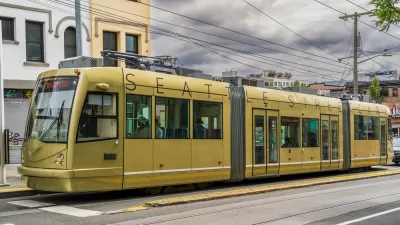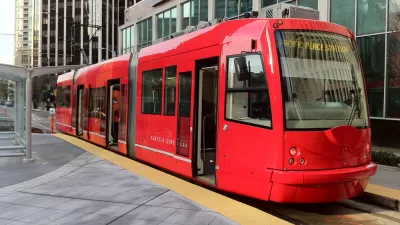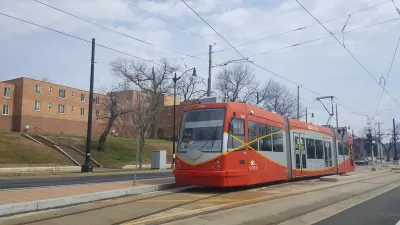Matt Fikse calls attention to a Seattle transit plan, which has few drawbacks but has been left to die by officials. Why the streetcar beat out the Rapid Trolley Network.
"Planners developed routes, cost estimates, and ridership projections for several alternatives. The summary, with the prosaic title 'Scenario Development Documentation, Portfolio 4.3', was included in the mountain of documents prepared for the Alaskan Way Viaduct Stakeholders group - to little notice. It is, for all intents, a road map for the Green Lines.
Its conclusions are breathtaking: Metro estimated that a Rapid Trolley Network would increase ridership by 60%, from 24 million to 38 million annual riders, while reducing overall emissions 60% over diesel buses and practically eliminating tailpipe emissions.
The kicker? The report calls the Rapid Trolley Network plan the best transit value in town, bar none: "The estimated marginal cost of $1.24 per new rider is lower than any other improvement." Total capital cost of the Rapid Trolley Network was pegged at $142 million including new passenger amenities, new extensions to Madison Park, connections to the Othello and Henderson Street light rail stations, new connector routes through the Central District, Downtown, and along Denny Way."
"Where has such a good idea gone? Nowhere, mostly. This underscores a problem with the deep-bore tunnel selection for the Viaduct replacement: ideas that had been associated with the Surface/Transit option - ideas with practical benefits independent of the tunnel - now seem to be on the back burner if not altogether dead."
FULL STORY: Good transit plan gone missing

Maui's Vacation Rental Debate Turns Ugly
Verbal attacks, misinformation campaigns and fistfights plague a high-stakes debate to convert thousands of vacation rentals into long-term housing.

Planetizen Federal Action Tracker
A weekly monitor of how Trump’s orders and actions are impacting planners and planning in America.

Chicago’s Ghost Rails
Just beneath the surface of the modern city lie the remnants of its expansive early 20th-century streetcar system.

Bend, Oregon Zoning Reforms Prioritize Small-Scale Housing
The city altered its zoning code to allow multi-family housing and eliminated parking mandates citywide.

Amtrak Cutting Jobs, Funding to High-Speed Rail
The agency plans to cut 10 percent of its workforce and has confirmed it will not fund new high-speed rail projects.

LA Denies Basic Services to Unhoused Residents
The city has repeatedly failed to respond to requests for trash pickup at encampment sites, and eliminated a program that provided mobile showers and toilets.
Urban Design for Planners 1: Software Tools
This six-course series explores essential urban design concepts using open source software and equips planners with the tools they need to participate fully in the urban design process.
Planning for Universal Design
Learn the tools for implementing Universal Design in planning regulations.
planning NEXT
Appalachian Highlands Housing Partners
Mpact (founded as Rail~Volution)
City of Camden Redevelopment Agency
City of Astoria
City of Portland
City of Laramie





























